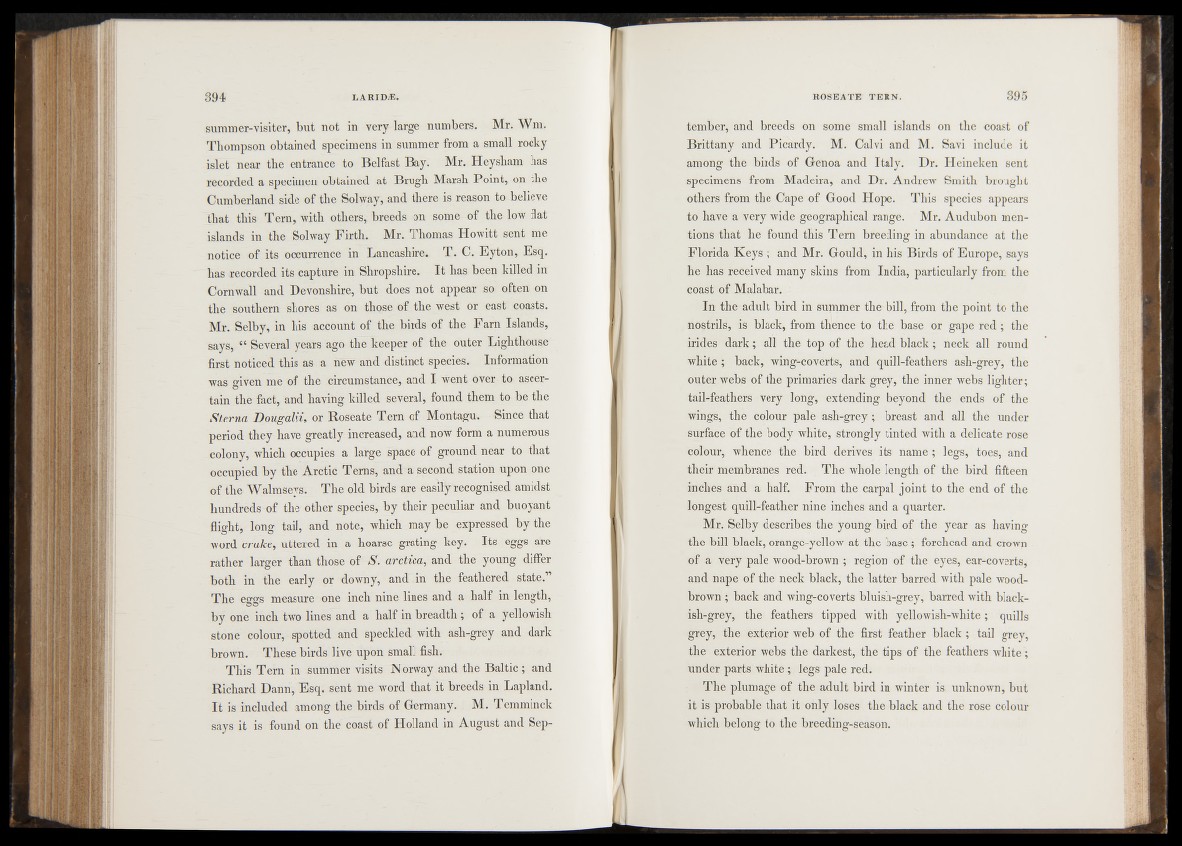
summer-visiter, but not in very large numbers. Mr. W ®
Thompson obtained specimens in'summer from a small rocky
islet near the entrance to Belfast Bay. Mr. Heysham has
recorded a specimen obtained at Brugh Marsh Point, on the
Cumberland side of the Solway, and there is reason to^helieve
that this Tern, with others, breeds on some- of thpdow flat
islands in the Solway Firth. Mr. Thomas Howitt sent me
notice of its occurrence in Lancashire* T. C. Eyton, Esp.
has recorded its Capture in Shropshire. I t has been killed in
Cornwall and Devonshire, but does not appear so often on
the southern shores as on thqse of the west or east? coasts.
Mr. Selby, in his account of the birds of the Earn Islands,
says* ** Several years ago the keeper of the outer Lighthouse'
first noticed this as a new- and distinct species* Information
was given me of the circumstance, and I went over to ascertain
the fact, and having killed several, found them to be the
Sterna Dougalii, or Roseate Tern of Montagu. Since that
period they have greatly increased, and now form a numerous
colony, which occupies a large space of ground nearsip. that
occupied by the Arctic Terns, and'a second station upon one
of the-Walmseyjr.; The b lf birds are’e a sie r ecognis.ed amidst
hundreds-of the other species, by their peculiar and buoyant
flight, long tad, and note, which may be expressed by the
word crake, uttered in a hoarse grating key. Its eggs are
rather-larger than those ofr S. arctica, and the“ young differ
both in the early or downy, and . in the-feathered state.”
The esrars measure one inch nine lines and a half in length,
by one inch two lines and a half in breadth-;; of a yellowish
stone colour,- spotted and speckled- with ash-grey and dark
brown. These birds live upon small fish.
This Tern in summer visits Norway, and the Baltic; and
Richard Danii, Esq* sent me word that i t breeds in Lapland.
I t is included among the birds of Germany. , M. Temminck
says it is found on the coast of Holland in August and; September,
and breeds on some small islands on the coast of
Brittany and Picifrdy. M. Calvi and M. Savi include it
among the thirds of Genoa and Italy. Dr. Heineken sent
specimens from Madeira, and Dr. Andrew Smith brought
others from the Cape of Good Hope. This species appears
to have a very wide geographical range. Mr. Audubon mentions
that he found this Tern breeding in abundance at the
Florida Keys ; and Mr. Gould, in his Birds of Europe, says
he has received many skins from India, particularly from the
coast of Malabar. -
In the adult bird in s u m m e r the bill,.from the point to the
nostrils, is black, from thence to thé base or gape red ; the
irides dark; all the top of the head black ; neck all round
white ; back, wing-coverts, and quill-feathers ash-grey, the
outer.webs of the primaries-dark grey, the inner webs lighter;
tail-feathers - very long, extending beyond the ends óf the
wings, the colour pale nsh-grey ; breast and all the under
surface of the body white, strongly tinted with a -delicate rose
colour, whence the bird derives its name ; legs, toes, and
their membranes red. f The whole length of the bird fifteen
inches and a half. From the carpal joint to the end of the
longest quill-featkfêr nine. incheS^and a quarter.
Mr. Selby describe^ the young bird of the year as having
the bill black, orange-yell^ atNite base ; forehead and crown
of a very pale wóod-brown ; region of the eyes, ear-coverts*
anifenape of the neck black,' st-Eö flatter barred with pale wood-
brown ; back and wing-coverts bluish-grey, barred with blackish
grey,' the feathers tipped with yellowish-white ; quills
grey, the exterior web of the first feather black ; tail grey,
the exterior webs the darkest, the tips of the feathers white ;
under parts whites^! legs pale red.
The plumage of the adults bird in winter is. unknown, but
it is probable that it only loses the black and the rose colour
which belong to the breeding-season.